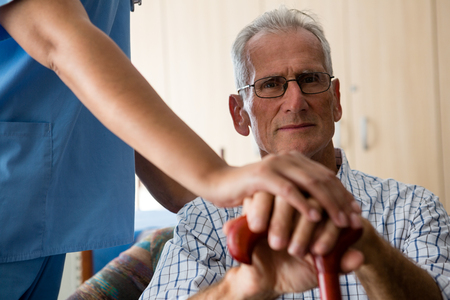Introduction to Elderly Rehabilitation in the UK
Rehabilitation for older adults is a fundamental aspect of healthcare in the United Kingdom, reflecting both societal values and clinical priorities. As the population ages, an increasing number of elderly individuals require structured support to recover from illness, injury, or surgery, and to maintain independence for as long as possible. The UK offers a diverse range of rehabilitation services designed to address these needs, predominantly delivered through the National Health Service (NHS) community services and complemented by private sector providers. The significance of effective rehabilitation cannot be understated; it not only enhances the quality of life for elderly individuals but also alleviates pressures on acute health and social care systems. Support systems, whether rooted in the public sector or accessed privately, play a crucial role in ensuring that care is tailored to individual circumstances. This personalised approach is particularly relevant in Britain, where respect for patient autonomy and dignity are key tenets of care delivery. By exploring the landscape of rehabilitation provision across NHS and private sectors, we can better understand how these frameworks strive to meet the evolving needs of the UKs elderly population.
2. Structure of NHS Community Rehabilitation Services
The National Health Service (NHS) in the UK delivers rehabilitation for elderly patients through an integrated community-based model. This structure ensures accessible and equitable care, bridging the transition from hospital to home and supporting older adults in regaining independence. The process is underpinned by standardised referral pathways, multidisciplinary team (MDT) collaboration, and a range of therapeutic interventions tailored to individual needs.
Referral Processes within the NHS
Accessing NHS community rehabilitation typically begins with a referral. Referrals can originate from hospital discharge coordinators, general practitioners (GPs), or community nurses. The process ensures that elderly individuals who require further support after acute treatment are promptly identified and assessed for suitability. In most regions, there are clear eligibility criteria, prioritising those at risk of hospital readmission or requiring assistance to return to independent living.
Role of Multidisciplinary Teams (MDTs)
A cornerstone of the NHS approach is its reliance on multidisciplinary teams. MDTs comprise professionals such as physiotherapists, occupational therapists, speech and language therapists, nurses, social workers, and sometimes clinical psychologists or dietitians. The team collaborates to develop person-centred care plans that address physical, psychological, and social aspects of rehabilitation.
Typical Composition of NHS Community Rehabilitation MDTs
| Professional | Main Responsibilities |
|---|---|
| Physiotherapist | Mobility training, exercise programmes, falls prevention |
| Occupational Therapist | Daily living skills, home adaptations, equipment provision |
| Nurse | Medication management, wound care, chronic disease monitoring |
| Speech & Language Therapist | Communication support, swallowing assessments |
| Social Worker | Social support, care coordination, safeguarding |
Common Types of Therapies Offered
The therapies provided within NHS community rehabilitation are evidence-based and cater to the diverse needs of elderly patients. Key interventions include:
- Physiotherapy: Focused on restoring mobility and strength post-illness or injury.
- Occupational Therapy: Assists with adapting daily routines and environments to maximise independence.
- Speech and Language Therapy: Addresses communication difficulties and safe eating/swallowing practices.
- Nursing Care: Includes health monitoring, medication administration, and education for self-management.
- Psycho-social Support: MDTs may also provide mental health interventions or refer to specialist services when needed.
NHS Community Rehabilitation Delivery Settings
| Setting | Description |
|---|---|
| Home Visits | Therapists deliver personalised care directly in the patients home environment. |
| Community Clinics | Centrally located facilities where group or individual sessions take place. |
| Care Homes | Rehabilitation provided to residents within long-term care settings. |
| Virtual/Remote Services | Certain therapies offered via telephone or video consultations where appropriate. |
This structured approach under the NHS ensures continuity of care for elderly patients throughout their rehabilitation journey. By leveraging multidisciplinary expertise and a variety of delivery methods, the NHS aims to optimise recovery outcomes and promote sustained independence in later life.

3. Private Providers: Approaches and Availability
When considering rehabilitation for the elderly in the UK, private providers present an alternative to NHS community services, characterised by distinctive approaches, wider diversity in service provision, and varied access routes. Understanding how these private sector options differ from their NHS counterparts is vital for families and individuals making informed choices about care.
Diversity in Service Provision
Private rehabilitation providers encompass a broad spectrum of organisations, including independent physiotherapy clinics, occupational therapy practices, specialist rehabilitation centres, and home-based care agencies. Unlike the standardised protocols often seen within the NHS, private services tend to offer more tailored interventions—ranging from intensive neuro-rehabilitation programmes to bespoke falls prevention or mobility enhancement sessions. This diversity allows providers to respond flexibly to the specific needs and preferences of elderly clients, frequently incorporating complementary therapies or advanced technologies that may not be routinely available on the NHS.
Access Routes and Referral Processes
One of the fundamental differences between private and NHS rehabilitation lies in access routes. Private care does not generally require GP referral; clients can self-refer or be directed through family members or other health professionals. This streamlined process can result in reduced waiting times and faster commencement of treatment—an important consideration for elderly individuals where early intervention can significantly influence outcomes. Additionally, many private providers offer initial assessments at short notice and flexible appointment scheduling, including evenings or weekends to accommodate family involvement.
Typical Models of Care Outside the NHS Framework
The models of care in the private sector are often shaped by market demand and individual client circumstances. Common approaches include one-to-one therapy sessions conducted either at purpose-built facilities or within a client’s own home environment—a model which is particularly valued by those with mobility issues or cognitive impairments. Some private organisations offer multidisciplinary input, coordinating physiotherapists, occupational therapists, speech and language therapists, and even dietitians as part of a holistic package. Packages can be purchased on a sessional basis or as part of longer-term contracts tailored to ongoing rehabilitation goals.
Conclusion: Flexibility Versus Standardisation
In summary, private providers in the UK bring flexibility, speed of access, and diversity in therapeutic options to elderly rehabilitation. While this can improve client satisfaction and outcomes for those able to afford such services, it is important to recognise that provision may vary greatly depending on geographic location and provider expertise. This stands in contrast to the more standardised but potentially less responsive model offered by NHS community services.
4. Comparing Access and Waiting Times
When assessing rehabilitation services for the elderly, a critical distinction emerges between NHS community provisions and private sector alternatives in terms of access, waiting times, and eligibility criteria. These factors fundamentally impact patient outcomes and the overall experience for older adults seeking rehabilitation support.
Accessibility: Entry Points and Coverage
The NHS operates a universal access model, offering rehabilitation to all eligible UK residents based on clinical need. Entry typically involves referral from a GP or hospital consultant, with services provided at no direct cost to patients. However, geographic disparities can exist, with rural areas sometimes experiencing reduced service coverage or fewer specialist staff compared to urban centres. Private providers, conversely, offer direct access with self-referral options and flexible locations but at significant personal expense. Private services may also provide home-based or rapid-response options not routinely available through the NHS.
Waiting Times: Speed of Service Delivery
| Service Provider | Average Waiting Time | Urgency Pathways |
|---|---|---|
| NHS Community Services | 2–12 weeks (varies by region and demand) | Prioritised for acute needs; routine cases may wait longer |
| Private Providers | Typically 1–7 days | Immediate appointments usually available upon payment |
This difference in waiting times is often cited as a key reason why some older adults or their families consider private rehabilitation, particularly when timely intervention is linked to improved recovery outcomes.
Eligibility Criteria: Who Qualifies?
The NHS applies strict eligibility criteria to ensure equitable allocation of limited resources. Assessment tools determine clinical need, functional impairment, and potential benefit from therapy. Those not meeting thresholds may face exclusion or be placed on lower-priority lists. Private providers generally have more flexible criteria, accepting clients regardless of medical urgency—provided they can afford the fees. This flexibility can be advantageous for those who fall just short of NHS thresholds yet still require support.
Summary Table: Key Differences in Access and Waiting Times
| NHS Community Rehabilitation | Private Sector Rehabilitation | |
|---|---|---|
| Cost to Patient | No direct charge (publicly funded) | Significant out-of-pocket expenses |
| Access Route | GP/hospital referral required | Self-referral or direct booking possible |
| Typical Waiting Time | Weeks to months depending on priority and location | A few days to one week; minimal delay |
| Eligibility Criteria | Strict, based on assessed clinical need | Largely open, dependent on ability to pay |
| Geographical Coverage | Nationwide but variable by region | Mainly urban; variable rural presence |
The comparative analysis underscores that while the NHS remains committed to equity and comprehensive coverage, private providers excel in speed and flexibility—albeit with greater costs and potential inequalities in access for those unable to pay.
5. Quality of Care and Patient Outcomes
Quality Assurance Mechanisms
In the UK, both NHS community rehabilitation services and private providers are subject to regulatory oversight, though the mechanisms and intensity may differ. The Care Quality Commission (CQC) plays a central role in inspecting and rating both sectors against established standards of care, such as safety, effectiveness, and responsiveness. NHS services typically follow rigorous protocols mandated by national guidelines like those from NICE (National Institute for Health and Care Excellence), with regular internal audits and peer reviews. Private providers also undergo CQC inspections, but their quality assurance processes can be more variable depending on organisational size and resources.
Standards of Care
NHS community services prioritise equitable access and continuity of care, often working within multidisciplinary teams to deliver holistic support tailored to individual needs. Standards are informed by evidence-based practice and are designed to be consistent across the country. Private providers may offer more flexible or specialised rehabilitation programmes, sometimes boasting shorter waiting times or bespoke interventions; however, the uniformity of standards can vary more widely due to differences in funding structures and staffing models.
Regulatory Oversight
The CQC ensures that both NHS and private services meet minimum statutory requirements for safe and effective care. However, NHS services are generally subject to additional scrutiny through public accountability measures and reporting requirements set by NHS England. Conversely, private providers must balance compliance with commercial imperatives, which can occasionally affect staffing ratios or investment in facilities. Both sectors face ongoing pressure to demonstrate transparent outcomes and continuous improvement.
Patient Satisfaction and Reported Outcomes
Patient satisfaction is a key indicator used to evaluate the success of rehabilitation services for the elderly. Surveys such as the NHS Friends and Family Test indicate that many patients value the familiarity, integration with primary care, and long-term support offered by NHS community teams. In contrast, private providers often receive positive feedback regarding convenience, individual attention, and amenities. Nonetheless, outcome data reveal a complex picture: while some studies suggest marginally better functional gains in certain private settings due to intensive input, others highlight parity in results when controlling for patient demographics and baseline conditions.
Comparative Insights
Ultimately, the quality of care in elderly rehabilitation depends not only on sector but also on local implementation, staff expertise, and patient engagement. Both NHS and private sectors strive for high standards, but their approaches reflect differing priorities—public accountability versus consumer choice. Continuous monitoring, robust regulation, and active patient involvement remain essential for ensuring that all older adults receive safe, dignified, and effective rehabilitation regardless of provider.
6. Cost Implications and Funding Options
When considering rehabilitation for the elderly, cost is a significant factor that influences both the accessibility and quality of care. In the UK, funding options for rehabilitation services differ markedly between NHS community services and private providers, and these differences have direct implications for elderly patients and their families.
NHS Funding: Accessibility and Limitations
The National Health Service (NHS) is predominantly funded through taxation, providing most community rehabilitation services free at the point of delivery. This means that elderly individuals who qualify for NHS care are not directly charged for standard rehabilitation programmes, including physiotherapy, occupational therapy, or speech therapy within community settings. However, resource limitations can result in waiting lists, eligibility assessments, or restrictions on the frequency and duration of sessions.
Self-Pay Routes: Flexibility versus Affordability
Private providers offer self-pay options for those willing or able to fund their own rehabilitation. This route often provides quicker access to services, greater flexibility in choosing therapists or facilities, and potentially more intensive or tailored interventions. Nevertheless, the financial burden can be substantial, particularly for prolonged or complex rehabilitation needs. The cost structure varies widely depending on provider reputation, location, and service scope.
Insurance Acceptance: Expanding Choice
While some private rehabilitation providers accept private medical insurance—covering all or part of the costs—uptake among the elderly remains limited due to pre-existing condition exclusions or high premiums. For families with adequate insurance coverage, this option can significantly expand service choice and reduce out-of-pocket expenses, although it may still require co-payments or adherence to insurer-approved provider networks.
Impact on Service Choice
The interplay of these funding mechanisms shapes service choice for elderly patients and their families. Those reliant solely on NHS provision may face constrained options regarding provider selection and speed of access but benefit from comprehensive coverage without direct financial pressure. Conversely, those pursuing private routes must weigh enhanced autonomy against financial sustainability. Ultimately, cost considerations are integral to decision-making around elderly rehabilitation, influencing both immediate care pathways and long-term health outcomes.
7. Future Directions and Policy Considerations
The landscape of elderly rehabilitation in the UK is facing a period of significant transformation, shaped by demographic shifts, technological advancements, and ongoing debates over healthcare funding and provision. As both NHS community services and private providers strive to meet the evolving needs of an ageing population, several current challenges and future developments are emerging that demand careful policy consideration.
Current Challenges in Rehabilitation Provision
One of the principal difficulties lies in balancing accessibility and quality across sectors. NHS community services continue to grapple with resource constraints, workforce shortages, and increasing demand for long-term rehabilitative care. Waiting times for assessments or therapy sessions often frustrate patients and families. In contrast, while private providers may offer swifter access and tailored programmes, cost remains a prohibitive factor for many elderly individuals who lack private insurance or disposable income.
Emerging Trends and Innovations
Future directions point towards a greater integration of technology—such as tele-rehabilitation platforms, remote monitoring devices, and digital care planning tools—which can enhance continuity of care across both public and private settings. There is also a growing emphasis on multidisciplinary approaches, where physiotherapists, occupational therapists, nurses, social workers, and carers collaborate more closely around individualised care plans. These innovations promise improved outcomes but require robust frameworks for data sharing, privacy protection, and staff training.
Policy Debates: Funding, Regulation, and Equity
The debate surrounding the appropriate balance between public funding and private sector involvement remains lively within UK health policy circles. Key questions include whether increased investment in NHS community rehabilitation would reduce hospital admissions and improve long-term outcomes—or whether a mixed economy model, leveraging the strengths of both sectors, delivers better value for money. Policymakers are also considering how regulation can ensure high standards across all providers without stifling innovation or widening inequalities in access.
Looking Ahead: Building a Sustainable System
To secure the future of rehabilitation services for the elderly, it is essential to address workforce development, foster partnerships between NHS trusts and independent providers, and embed patient voices in service design. National strategies must focus not only on expanding capacity but also on ensuring equitable access regardless of socioeconomic status or geographic location.
In summary, the future of elderly rehabilitation in the UK hinges on effective collaboration between sectors, ongoing investment in people and technology, and agile policymaking that keeps pace with changing needs. Achieving these goals will be critical to supporting older adults’ independence, dignity, and quality of life in the years ahead.


